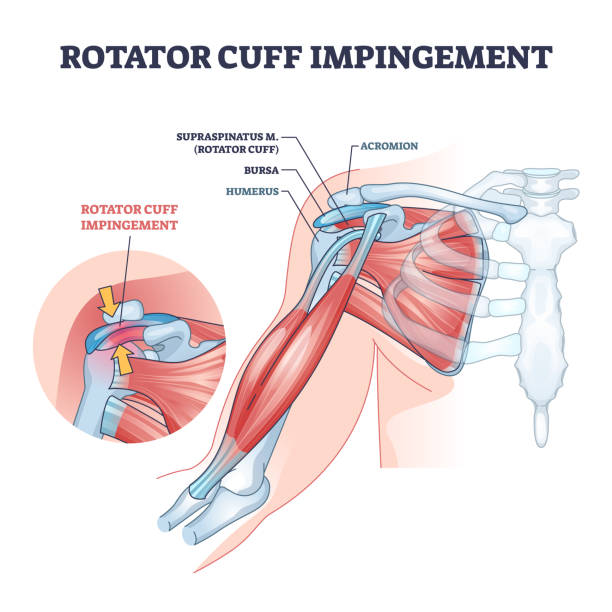- Details
- Hits: 40
Sports that involve repeatedly raising the arm above the head in a repetitive gesture can, in the long run, inflame the muscle tendons and cause shoulder overload pathologies.
Swimming is the sport that causes or can cause this type of problem therefore, in sports jargon, it is called swimmer's shoulder.
Shoulder composition.
The shoulder is a connection area between the upper limb (humerus), the clavicle and the scapula.
It manages to offer high degrees of mobility through the 5 joints that compose it:
1. the glenohumeral,
2. acromioclavicular,
3. sternoclavicular,
4. scapulothoracic,
5. subdeltoid,

They determine a large amplitude movement between all the joints of the human body. This favorable aspect, however, has its downside: if something does not work well, instability, imbalances and dysfunctions result.
The correct position of the head of the humerus, the "centric" position, is not guaranteed by the osteo-cartilaginous part, but by the balance of the muscle-tendon structures of the rotator cuff, i.e. by the muscles and related tendons such as:
- the supraspinatus,
- the infraspinatus teres minor,
- the subscapularis together with others (deltoid, rhomboids etc.), contribute to the stabilization of the shoulder.
This pain is caused by sub-acromial impingement and is one of the most frequent pathologies that cause shoulder pain: every time the upper limb is raised beyond a certain degree, there is a narrowing of the space between the humeral head and the acromion ( the anatomical part of the scapula) where the rotator cuff tendons slide.
Thus in the repetition of certain athletic gestures or more normal Thus in the repetition of certain athletic gestures or more normal work tasks, the increase in friction within this space causes inflammation of the structures contained within it.
The repeated movement of the tendon of the supraspinatus muscle under the coracoacrominial arch, caused in turn by the repeated abduction of the shoulder and its anterior flexion during the stroke, particularly in the free and dolphin styles.
Subascromial rotator cuff impingement syndrome
It is typically caused by altered kinematics, caused by muscle fatigue or laxity.
In swimmers, as in athletes of many sports, adaptations occur, such as limited internal rotation and excessive external rotation.
When the rotator cuff tendons and scapular stabilizers fail to keep the humeral head centered in the glenoid cavity, excessive translation of the humeral head and consequently tendon rotator cuff impingement syndrome may occur.
Overuse and resulting muscle fatigue
For most of the stroke, the most active muscles are the subscapularis and the serratus anterior, which are therefore subject to fatigue..
As these muscles fatigue, shoulder kinematics may be altered, often resulting in secondary rotator cuff impingement syndrome.
Scapular dyskinesia
Scapular protraction is a common sign of scapular dyskinesia in swimmers.
When the serratus anterior and subscapularis become fatigued, the pectoralis major stresses the glenohumeral joint anteriorly which can result in unusual scapular motion, narrowing the subacromial space and thus resulting cuff impingement syndrome.
Laxity and instability
Excessive translation of the humeral head into the glenoid cavity is usually prevented during sports movements thanks to the static stabilizers of the shoulder joint (glenoid labrum and capsuloligamentous system) and dynamic stabilizers (rotator cuff and scapular muscles).
Prevention and Treatment
Some athletes may be predisposed to the development of swimmer's shoulder when certain anatomical conditions are already present.
It would be advisable to verify the presence of these unfavorable conditions at the beginning of preparation, in order to draw up a preventive training program, then adapting it to the characteristics of the swimmer's specialty.
Before starting an athlete's training, to avoid the appearance of this pain in the future, the presence of postural deviations, hypomobility of the spine, shortened chest muscles, excessive or limited mobility of the shoulder joint, functional alterations and level of the rotator cuff and scapula.
Posture
We intervene on the mobilization of the joint tissues, on flexibility, inserting strengthening/stabilization exercises of the scapular retractors and the deep cervical muscles.
The shortened chest muscles should be lengthened, taking care not to overstretch the anterior capsule.
Joint mobility
In swimmer's shoulder, tightness of the posterior capsule may accompany laxity in the anterior part of the shoulder.
Stabilization of the scapula
The stability of the scapula and a correct scapulohumeral rhythm are essential for the prevention and rehabilitation of the shoulder.
The position of the scapula directly influences the position of the head of the humerus, also acting on the rotator cuff and the tension expressed by these muscles, as they originate on the scapula, increasing the risk of injury.
The muscles to be evaluated and fundamental for the stability of the scapula are the middle and lower trapezius, the serratus anterior and the rhomboids.




 1
1 2
2 3
3




